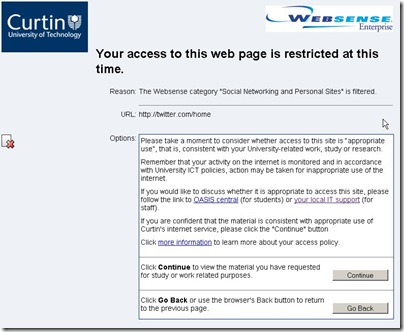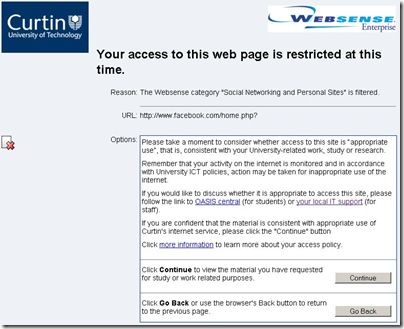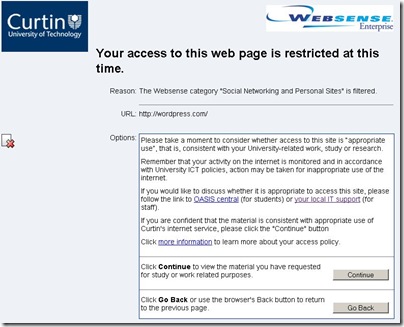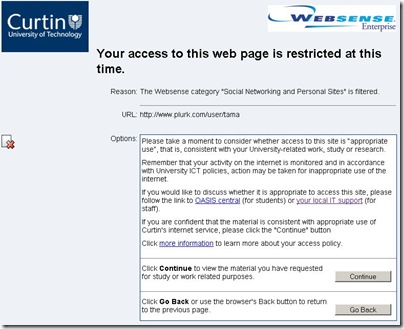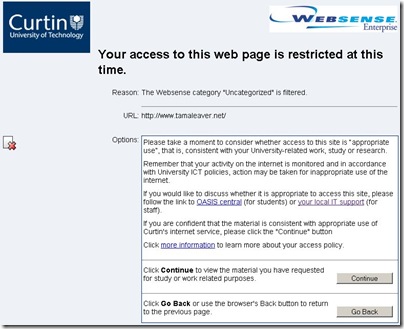Home » education (Page 4)
Category Archives: education
A Day in the Internet
Some useful comparisons for teaching about teh Interwebs …

Created by OnlineEducation.net [Via Jill]
Digital Culture Links: November 23rd 2009
Links for November 17th 2009 through November 23rd 2009:
- Microsoft and News Corp eye web pact [FT.com] – “Microsoft has had discussions with News Corp over a plan that would involve the media company’s being paid to “de-index” its news websites from Google, setting the scene for a search engine battle that could offer a ray of light to the newspaper industry. The impetus for the discussions came from News Corp, owner of newspapers ranging from the Wall Street Journal of the US to The Sun of the UK, said a person familiar with the situation, who warned that talks were at an early stage. However, the Financial Times has learnt that Microsoft has also approached other big online publishers to persuade them to remove their sites from Google’s search engine. News Corp and Microsoft, which owns the rival Bing search engine, declined to comment.” (NewsCorp + Microsoft = B(e)ing Evil!) [Via]
- Teachers warned off online Facebook contact with students [PerthNow] – “Teachers[in Western Australia] would be banned from contacting students on social-networking websites like Facebook or Myspace under proposed changes to their code of ethics. The move comes after the WA College of Teaching disciplinary committee reprimanded about 10 teachers in the past year for inappropriate cyber interaction with students. The behaviour included teachers sharing private photos with students and in some cases engaging in online sexual innuendo. WACOT’s disciplinary committee chairwoman, Theresa Howe, said the code of ethics needed to be updated to specifically target inappropriate and over-friendly computer correspondence between students and teachers.”`We’re seeing an increase in it and it has to be specifically addressed,” she said. `That should be in both the code of ethics and in professional development courses for teachers.”
- Reporter Center’s Channel [YouTube] – A fantastic resource to help up and coming reporters, journalists and media students think about how to go about, and improve, the way they do things. [Via mUmbrella]
- BigPond pulls plug on Second Life [The Age] – “Telstra has decided to close its doors on Second Life, evicting the residents of its virtual BigPond Island and revoking their unmetered usage, in a move that has infuriated some subscribers. BigPond’s presence will cease on December 16, signalling an end to its two-year “experiment” with Second Life, and residents of the swanky virtual Pond Estate have been given a month to relocate elsewhere. Second Life is a virtual world that enables members to build or trade in-world objects and interact through their “avatars”. In its early days, new users flocked to the platform and organisations raced to set up a presence there to find new ways of engaging with their public, but the buzz surrounding virtual communities has since waned. According to a Second Life enthusiast, as many as 1600 users could be affected by BigPond’s closure, many of whom are socially isolated or disabled and unable to afford to continue maintaining their presence on the virtual world without unmetered usage.”
Learning, Authenticity & Online Policy Primers
This year I’ve been enjoying designing and implementing a series of new assignments and assessment techniques with students in our Internet Studies programmes. One of the most challenging things about working in Internet Studies is trying to make assignments authentic – which basically means doing assignments which can end up being meaningful and, ideally, viewable by the world-at-large on the Internet. One assignment that has worked particularly well and I thought worth sharing is from the unit Online Politics and Power, which looks at power in various guises and instances online.
One of the most interesting ways power is deployed online is through those infamous Terms of Use and Terms of Service which 95% of people never read, but always agree to, when signing up for a new service. So, I thought it’d be useful to ask students to really interrogate the Terms of Service of some online tools and platforms. More to the point, I wanted this to be a useful assignment beyond the confines of a university unit. So, I asked students to find a way to communicate the core elements of some Terms of Use in a way that would be accessible to the general public, hence an Online Policy Primer. (If you’re interested the assignment outline and requirements are online here.)
I have to say, I was blown away by how good the Primers are, and how, ultimately, useful they are, too. Also, while we did discuss the Creative Commons, I didn’t stipulate that students had to use a CC license, but I was delighted that many chose to do so. Of those that did, I’d like to share three stand-out examples.
The first, by Paula (@MXYZ_), takes a close look at Flickr’s Terms of Service and is licensed under a Creative Commons Attributions Share-Alike license [CC BY SA]:
The second, by Simon (@whoisimon) explores the Terms of Service for Slideshare and is licensed under a Creative Commons Attribution, Non-Commercial, Share-Alike license [CC BY NC SA]:
And the third, and final, policy primer I wanted to highlight is by Chea Hwey Yea, looking at Twitter’s Terms of Service and is also licensed under a Creative Commons Attribution, Non-Commercial, Share-Alike license [CC BY NC SA]:
These are just three examples of the many, many wonderful primers students created; while not everyone used a Creative Commons license, three more Primer’s worth highlighting are a machinima presentation exploring Second Life’s Terms of Service created by Rhys Moult, Renee Bird’s close look at the Terms of Use for the Multiplayer Online Game Evony, and Veronica Fry’s analysis of YouTube’s Terms of Service.
As you can see, these students have a lot to be proud of and have, in many cases, created Primers which are likely to be useful well beyond the confines of the unit!
Lessig’s Talk: Getting copyright right for education and science!
Lawrence Lessig gave an outstanding keynote speech for the Educause Conference, called ‘It is About Time: Getting Our Values Around Copyright’, delivered on 5 November 2009:
The talk is an hour long, but is well worth your time. There’s a few notes on the talk over at Inside Higher Ed. The guts of Lessig’s talk: we need to ensure that copyright doesn’t continue to be a mechanism which distances educators, researchers and scientists from sharing their thoughts, ideas and findings with the public and wider world. [Via D’Arcy Norman]
The Creative Commons: An Overview for Educators
[This post was originally published in Screen Education, 50, Winter 2008, pp. 38-42. It is reproduced here with permission. The article was (and is) aimed at media teachers in Australia, but hopefully may be of use more broadly, too.]
As teaching media and, more to the point, teaching media literacies becomes more and more central in both K-12 and tertiary settings, one of the biggest challenges is the gargantuan monolith of copyright. By copyright, I don’t necessarily mean teaching how copyright works – although that certainly isn’t the most straight forward process – but of more difficulty are the roadblocks that copyright laws puts in place. Immediately some canny readers will retort that most Australian schools and universities have access to particular exceptions which allow students to access and use material which, in any other context, falls under the rubric of All Rights Reserved. These exceptions are certainly very useful, but for the purposes of this article I’m relying on the notion that to be truly literate, skills must be transferable to the world outside of education. After all, if we taught our students to write and spell but told them they couldn’t use the alphabet outside of school grounds, basic literacy for all would never have caught on!
Media, of course, doesn’t have just one alphabet; as an idea, in practice, and even the literal meaning of the word reminds us that media is multiple. That multiplicity holds particular challenges for education. How, for example, do we teach students to integrate sound, still images, moving images and text without spending enormous amounts of time creating each of these media forms individually? One option is to teach the theory behind media production without including practical elements. However, as contemporary pedagogical theory and most practicing educators would agree, the best way to help students fully understand and engage with a particular concept or area is to put that notion into practice. It follows, then, that while media literacies can be taught by just analysing and critiquing films, television and video, often the most profound way to engage students in developing critical understanding of the media is when students create their own. So, what’s needed then is access to media which students can use, adapt, remix and build upon which isn’t All Rights Reserved. Sure there’s material that’s in the public domain and has no copyright restrictions, but it takes a very long time for most media to enter the public domain these days (different media forms take different lengths of time, but 70 years or longer is the length that film, television and music remain off limits). More to the point, even though copyright is automatically assigned as soon as a work is made these days, many creators want others to be able to re-use their work in particular ways. That’s where the Creative Commons organisation becomes important, along with the range of copyright licenses they’ve developed which can allow creators to be a lot more specific about how their creative work can be re-used following the principle of Some Rights Reserved.
What Is It?
In a nutshell, the Creative Commons organisation began in 2001 with the explicit mission of trying to make innovation and creativity easier for the many people who create media which, to some extent, builds upon existing work. They recognised that because authors of creative work had only two choices when creating a piece of media – either following the All Rights Reserved model of full copyright or giving up any and all rights and putting their work in the Public Domain – these limited options meant most people went along with All Rights Reserved because they weren’t prepared to give up all of their rights as creators. Meanwhile, many authors said that they’d happily let others use portions of their work in specific ways – and when directly contacted often gave others explicit permission to do just that – but many people argued that a system which let authors say which freedoms they’d give to others would be make it a thousand times easier for new creative works to be made, remixing, mashing or borrowing from previous work. And that’s exactly what the Creative Commons organisation has done: they’ve developed a series of licenses that can let authors make clear what they’re happy for other people to do with that author’s work. While standard copyright notices make explicit what can’t be done with a particular work, Creative Commons licenses allow people to specify what can be done.
How Does It Work?
The Creative Commons organisation provides a set of simple-to-use tools which let authors specify the sort of things they will and won’t let other people do with their creative work. The fundaments of the Creative Commons licenses are these four elements:
- Attribution (BY): Attribution basically means that the author of a work must be acknowledged by anyone who uses that work in any way in the future.
- Non-Commercial (NC): Non-commercial simply means that the author’s work can be re-used but not for commercial purposes – ie you can’t make money selling this work as a whole or a derivative part of it in a new work.
- No Derivatives (ND): No derivatives means that you can’t alter the work and can only redistribute verbatim copies (so, for example, if it was a song you could download it, listen to it and share it, but you couldn’t take a sample from the song to use in your own work).
- Share-Alike (SA): Share-Alike specifies that any derivative works (ie a new work which includes this work in part or in whole) must be licensed in exactly the same way (so if the original license was a Creative Commons Attribution Share-Alike license, then the new work created must use exactly the same licensing conditions).
These elements can thus be combined in different ways to form six possible Creative Commons licenses:
- Attribution: The work can be shared, sampled, re-mixed and so on as long as the original author of a work is acknowledged.
- Attribution, No Derivatives: The original author of a work must be acknowledged and no derivative works can be created using this piece (ie it can’t be sampled, bits can’t be used in new works).
- Attribution, Non-Commercial, No Derivatives License: Same as the previous license but with the extra stipulation that the work cannot be sold or distributed in any commercial manner.
- Attribution, Non-Commercial License: As long as authorship is acknowledged, the work can be used in any non-commercial way, including being sampled, remixed and so forth.
- Attribution, Non-Commercial, Share-Alike License: The same term as above, but with the added stipulation and all derivative works must be licensed using exactly the same terms.
- Attribution, Share-Alike License: So long as the original author of the work is acknowledged, it can be used, sampled and re-mixed as long as new works containing this piece are licensed under exactly the same terms.
While these licenses might sound a little confusing at times, it’s useful to think of them as the engine of the Creative Commons car: they need to be there to make everything work, but you don’t have to understand them in great detail in order to drive. Indeed, Creative Commons have set up a very simple website to help people choose a license, which is at http://creativecommons.org/license/. To choose a license, people just need to answer whether they want to allow commercial uses of their work and whether the want to allow modifications of their work and the website shows you the most appropriate license, complete with detailed instructions on how to add this license to your work (where your work can be anything from a document to an mp3 music file to a whole website).
But Isn’t Creative Commons American?
While the Creative Commons organisation is, indeed, based in the US, the great news is that there are local Creative Commons teams in many countries, including Australia. Apart from being extremely loud and clear advocates for Creative Commons across the board, from education though to entertainment, Creative Commons Australia (CCau) have also successfully implemented a national version of the Creative Commons licenses. This means that as educators, we can be 100% sure that Australian Creative Commons licenses will definitely be recognised in the Australia legal system. (This is especially significant since so many of the frustrating ambiguities in this area come from the fact that copyright laws differ across national boundaries.) When selecting a Creative Commons license using the website mentioned above, it’s also possible to simply select which jurisdiction you want to the license to fall under (so for Australia students and educators, ‘Australia’ is probably your best bet!).
Creative Commons in the Classroom
So, as an example, lets say that you’re a teacher of an upper secondary media class and you’ve asked the students to work in teams to create a short, topical, news report in a video format. They’ve got video cameras and editing software so can shoot the majority of the story themselves, but find during editing they need a few more bits of media: some music to jazz up the opening sequence, a couple of still images to use as cutaways during an interview, and some historical footage of the Olympic games (these students are doing a report on the Olympics, it turns out). Moreover, these students are hoping to post their news report on YouTube when they’re finished, showing it to family and friends. So, they’re going to need sources of secondary material that they have permission to re-use.
To find material, the students are already ahead of the game and head directly to the Creative Commons search portal (http://search.creativecommons.org) and they find some ‘fanfare’ music perfect for their opening sequence (the music has a Creative Commons Attribution license). Then the students click on a separate tab to search for images and find two amusing little images of the Chinese Olympics Mascots (Fuwa) and these are licensed using a Creative Commons, Attribution, Non-Commercial, Share-Alike license. Finally, the students head over to the Internet Archive (www.archive.org) and find some historical footage of the first ever Olympic Torch relay from the 1936 Olympics in Germany; this footage is old enough to be in the public domain. These secondary materials are added in and a brilliant story about Australia’s anticipation of the Olympic games is completed. Since their teacher has explained a bit about copyright and the Creative Commons, these students scan their secondary media and realise that with a combination of one public domain media piece, one using a Creative Commons Attribution license, and two using Creative Commons, Attribution, Non-Commercial, Share-Alike licenses, that their resulting news report will also need to be also licensed using a Creative Commons, Attribution, Non-Commercial, Share-Alike. The students hop onto the Creative Commons website, find a nifty little graphic file detailing their license, and place it as the final frame of their Olympic News Story.
Now, with a news story which can legally be re-distributed (as long as they don’t make money off it), this group of students post their video on YouTube. Their parents and peers are deeply impressed as it’s a great news story, and their clear understanding of copyright looks very professional! More to the point, a few weeks later the group of students get an email telling them that another group of students on the other side of the planet, in Canada, have included a clip from this Olympic News Report in a new student project in Canada, just as the Creative Commons license on that video allows them to do. Back in Australia the students and their teacher glow with pride knowing that they’ve not only created a wonderful news story, but it has also contributed to the global community and has been creatively built upon by others!
Introducing Creative Commons to Students
So you’re convinced about the value of Creative Commons licensing but can’t work out how to introduce them to your students? Thankfully, the Creative Commons folks have a lot of great media introducing their ethos, practice and licenses, all accessible via http://creativecommons.org/about/. Of particular use are the comic books which explain Creative Commons licenses via a superhero story, and a series of short web-based videos which introduce key Creative Commons ideas and features. Indeed, two of the best of these videos were produced by the Creative Commons Australia team, featuring the quirky animated characters Mayer and Bettle!
Where To Start?
So, you’re ready to give Creative Commons a go in your teaching and learning? Then here’s a few useful websites to get you started:
- www.creativecommons.org – The main website of the Creative Commons organisation with mountains of information.
- search.creativecommons.org – The search engine maintained by the Creative Commons organisation which lets you easily search many different databases for different media forms, all with Creative Commons licenses.
- creativecommons.org.au – The home of Creative Commons Australia and local efforts to promote the use and ethos of Creative Commons down under.
- www.archive.org – The Internet Archive, one of the world’s biggest repositories of historical material, a lot of which is either in the public domain or uses Creative Commons licenses. The Internet Archive has a lot of historical video material.
- www.flickr.com/creativecommons/ – The Creative Commons section of the massively popular photograph-sharing website Flickr has literally millions of different images available under Creative Commons licenses.
How to Stalk Your Kids on Facebook!
Once again, those satirists at the Onion have shed a little light on the privacy issues surrounding Facebook with this little video:
Facebook, Twitter Revolutionizing How Parents Stalk Their College-Aged Kids
Curtin’s Internet Filtering and Blocking
How much does your educational institution filter the internet, especially if you’re at tertiary level (because K-12 filtering has other issues attached to it)? I ask because in my recent shift to Curtin, I’ve discovered the joys of university-level internet filter, something that didn’t happen at my previous institution. The list of blocked or click-thru site (ie not completely blocked, but having a warning message asking if you really need this website) seems to alter week to week. This morning, every time I want to visit Twitter, Plurk, Facebook or even a wordpress.com blog, I have to click through a warning page; every time I reload, I have to click through a warning page. Apart from being highly frustrating, I’m currently redesigning several units which are thematically linked by the concept of web presence; almost everything I want students to look at will have these warnings on the Curtin network. I wonder how many students will get frustrated and give up on the unit? This morning’s blocks so far …
Ironic Update: The first attempt to upload this blog post from my work computer led me to discover that even this website is blocked now:
I wonder what sort of hoops I’m going to have to jump through to try and fix this? 🙁
Update 2: Most of the blocking seems to have magically stopped as suddenly as it began about 12 hours ago so, being generous, I’d like to believe this was an accidental blocking … I’d really like to believe that …
Annotated Digital Culture Links: February 8th 2009
Links for February 5th 2009 through February 8th 2009:
- Journalism Education’s Future: Broader, Deeper in Community [Center for Citizen Media] – Dan Gillmor, on the challenge for journalism educators in the C21st: “Journalism educators should be in the vanguard of an absolutely essential shift for society at large: helping our students, and people in our larger communities, to navigate and manage the myriad information streams of a media-saturated world.We need to help them understand why they need to become activists as consumers — by taking more responsibility for the quality of what they consume, in large part by becoming more critical thinkers. And they need to understand their emerging role as creators of media.
In both cases, as consumers and creators, we start with principles.
For media consumers:
• Be Skeptical
• Exercise Judgement
• Open Your Mind
• Keep Asking Questions
• Learn Media TechniquesFor media creators (after incorporating the above):
• Be Thorough
• Get it Right
• Insist on Fairness
• Think Independently
• Be Transparent, Demand Transparency” - Stimulus package Facebook activism [Larvatus Prodeo] – “Thanks to commenter Bird of paradox on a previous thread for drawing my attention to the creation of a Facebook group “Come on Turnbull, don’t take away my $950 bucks !”. As of this morning, it was the largest political Facebook group in Australia with 5000 members and a goal of 8000 by 9pm tonight. They’ll easily reach that. When I checked in five minutes ago, there were 7887 members. Another 60 have joined now. The group creator describes his motivation this way: ‘We are sending a clear message that Australians need this boost. As a uni student I need help to buy my text books, my mother is a single parent who needs help and my brother is heading into year 12 and he needs it… Think about how much difference this bonus will make to you and your families…’ The group page also provides information on how to lobby Senators. Very interesting indeed.” (Checking today there were more than 34,000 members!)
- Australians desert MySpace for Facebook [The Age] – “Facebook celebrates its fifth birthday this week and the company has much to crow about, as new figures reveal the social network has twice as many monthly users in Australia as its nearest competitor, MySpace. According to web traffic monitor Nielsen Online, Facebook attracted 4,682,000 unique visitors in December, compared with just 2,362,000 for MySpace. Furthermore, each Facebook user viewed 381 pages on Facebook but MySpace users looked at only 252 pages.
The figures show Australians appear to be deserting MySpace for Facebook … In Britain, the BBC reports, Facebook has 17 million users or three times as many as MySpace. Globally, ComScore released figures late last month showing 222 million people visited Facebook in December, versus 125 million for MySpace.”

